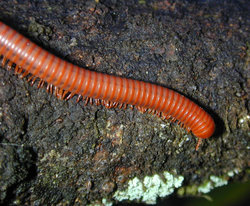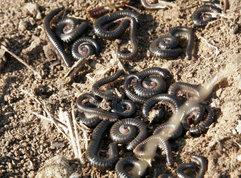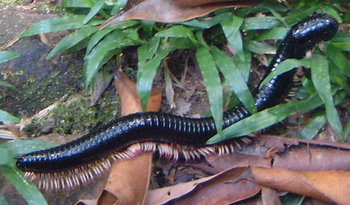Millipede
This page is about the creature known as the millipede. For other meanings, see Millipede (disambiguation). more...
Millipedes (Class Diplopoda, previously also known as Chilognatha) are very elongated arthropods with cylindrical bodies that have two pairs of legs for each one of their 20 to 100 or more body segments. These animals are herbivorous, slow and nonvenomous; unlike the somewhat similar and closely related centipedes (Class Chilopoda), which can be easily distinguished by their single pair of legs for each body segment. Most millipedes eat decaying leaves and other dead plant matter, moisturizing the food with secretions and then scraping it in with the jaws.
This class of arthropods is thought to be among the first animals to colonize land during the Silurian geologic period. These early forms probably ate mosses and primitive vascular plants.
The millipede's most obvious feature is its large number of legs. In fact its name is a compound word formed from the Latin roots milli ("thousand") and ped ("foot"). Despite their name, these creatures do not have a thousand legs, although some rare species are close enough with an amazing 750. However, common species have between 80 and 400 legs.
Having very many short legs makes millipedes rather slow, but they are powerful burrowers. Waving their body length and with the legs moving in a wavelike pattern, they easily force their way underground, head first. They also seem to have some engineering ability, reinforcing the tunnel by rearranging the particles around it.
Due to their lack of speed, millipedes' primary defense mechanism is to curl into a tight coil—protecting their delicate legs inside an armored body exterior. Many species also emit a somewhat poisonous liquid secretion, or hydrogen cyanide gas, through microscopic pores along the sides of their bodies as a secondary defense. Some of these substances are acidic and can burn the exoskeleton of ants and other insect predators, and the skin and eyes of larger predators. As far as humans are concerned, this chemical brew is fairly harmless, although it should never be eaten or applied to the eyes. Because of this, caution should be used when handling millipedes. Lemurs have been known to intentionally irritate millipedes in order to rub the chemicals on themselves to repel insect pests, and possibly to produce a psychoactive effect.
Read more at Wikipedia.org



